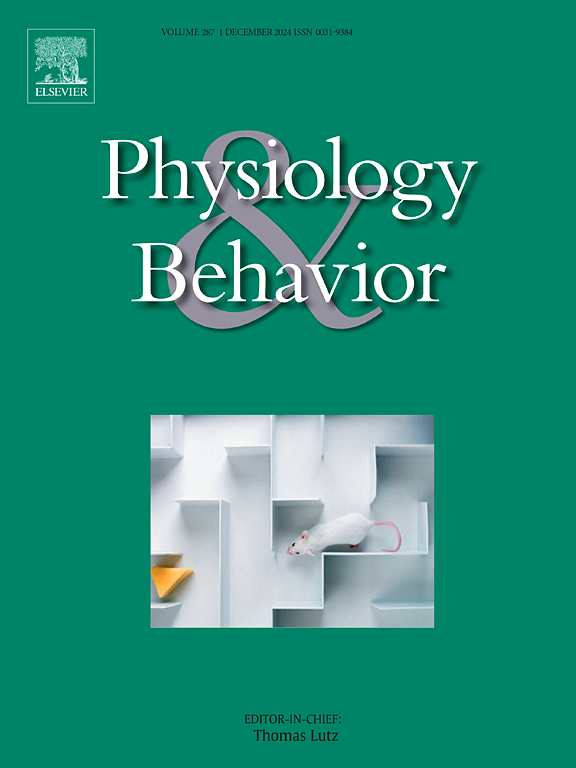有氧运动和全身振动干预对绝经后妇女肌肉因子和神经认知表现的影响。
IF 2.5
3区 医学
Q2 BEHAVIORAL SCIENCES
引用次数: 0
摘要
本研究研究了71名久坐健康绝经后妇女在全身振动(WBV)平台(MIAE+WBV)上进行中等强度有氧运动(MIAE)和MIAE联合等长阻力运动(NEI)对神经认知和分子指标的影响,并与不运动(NEI)的影响进行了比较。参与者被随机分为MIAE组(n=23)、MIAE+WBV组(n=23)和NEI组(n=25)。在干预前后评估神经认知测量,包括Stroop任务期间的准确率(AR)、反应时间(RT)和基于脑电图的事件相关电位(P2、N2和P3分量),以及胰岛素样生长因子1 (IGF-1)、去甲肾上腺素(NE)、骨钙素(OC)、羧化OC (cOC)和未羧化OC (ucOC)的血清水平。尽管相容条件下的反应时间(RT)、ERP潜伏期或N2或P3振幅没有显著变化,但两组在不相容条件下的正确率(AR)和P3振幅均有显著增加。只有MIAE+WBV组在相容条件下的ar和不相容条件下的P2振幅有所改善。运动后,两组均表现出IGF-1、NE、OC和ucOC水平升高,MIAE+WBV组中,MIAE后WBV导致IGF-1、OC、cOC和ucOC升高。NE和P3振幅的变化以及ucOC水平和ar之间存在显著相关性,突出了分子和神经认知结果之间的联系。研究表明,MIAE和MIAE+WBV都是改善绝经后妇女神经认知和骨骼健康的有效方法,其中MIAE+WBV比单独使用MIAE更有效。本文章由计算机程序翻译,如有差异,请以英文原文为准。
Impacts of aerobic exercise and whole-body vibration interventions on myokines and neurocognitive performance in postmenopausal women
This study investigated the effects of moderate-intensity aerobic exercise (MIAE) and MIAE combined with isometric resistance exercise on a whole-body vibration (WBV) platform (MIAE+WBV) compared with the effects of no exercise (NEI) on neurocognitive and molecular indices in 71 sedentary, healthy postmenopausal women. Participants were randomly assigned to MIAE (n = 23), MIAE+WBV (n = 23), and NEI (n = 25) groups. Neurocognitive measures, including accuracy rate (AR), reaction time (RT), and electroencephalogram-based event-related potentials (P2, N2, and P3 components) during the Stroop task, in addition to serum levels of insulin-like growth factor 1 (IGF-1), norepinephrine (NE), osteocalcin (OC), carboxylated OC (cOC), and uncarboxylated OC (ucOC), were evaluated before and after the intervention. Although no significant changes were observed in reaction times (RT), ERP latencies, or N2 or P3 amplitudes for the compatible condition, both exercise groups showed significant increases in accuracy rate (AR) and P3 amplitude for the incompatible condition. Only the MIAE+WBV group exhibited improvements in ARs for the compatible condition and P2 amplitudes for the incompatible condition. After exercise, both groups exhibited elevated IGF-1, NE, OC, and ucOC levels, with WBV following MIAE resulting in increases in IGF-1, OC, cOC, and ucOC in the MIAE+WBV group. Significant correlations were observed between changes in NE and P3 amplitude and between ucOC levels and ARs, highlighting links between molecular and neurocognitive outcomes. The study shows that both MIAE and MIAE+WBV can be effective approaches to improving neurocognitive and bone health in postmenopausal women, with MIAE+WBV being more effective than MIAE alone.
求助全文
通过发布文献求助,成功后即可免费获取论文全文。
去求助
来源期刊

Physiology & Behavior
医学-行为科学
CiteScore
5.70
自引率
3.40%
发文量
274
审稿时长
47 days
期刊介绍:
Physiology & Behavior is aimed at the causal physiological mechanisms of behavior and its modulation by environmental factors. The journal invites original reports in the broad area of behavioral and cognitive neuroscience, in which at least one variable is physiological and the primary emphasis and theoretical context are behavioral. The range of subjects includes behavioral neuroendocrinology, psychoneuroimmunology, learning and memory, ingestion, social behavior, and studies related to the mechanisms of psychopathology. Contemporary reviews and theoretical articles are welcomed and the Editors invite such proposals from interested authors.
 求助内容:
求助内容: 应助结果提醒方式:
应助结果提醒方式:


